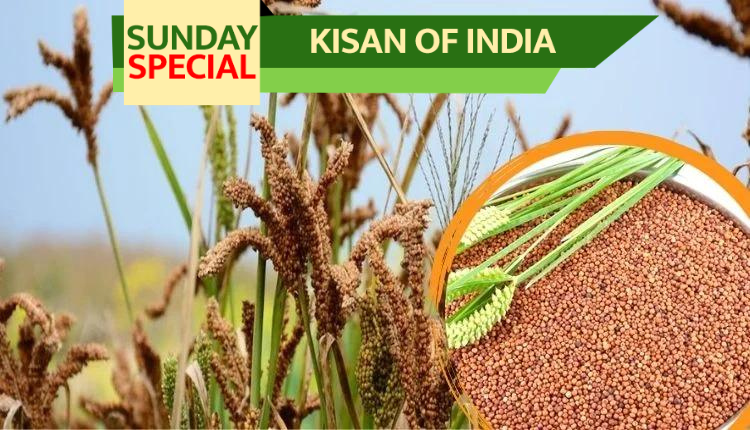Ragi Cultivation (Mandua): Know how to earns good income
If both paddy and ragi are planted together in two rows, then both give good yield.
Ragi i.e. Mandua is a Kharif crop. Ragi cultivation is done in many states. Ragi crops are very tolerant of drought and weeds. Ragi has the ability to tolerate normal waterlogging. This quality of Raagi makes it very useful for rainfed i.e. rain-dependent and drought-prone areas.
That is why even in areas with less rainfall like Bundelkhand, the ragi crop gives a good yield. However, the major producer of Mandua in Jharkhand. It can also be grown as an intercrop with paddy in fertile fields. In this way, ragi has a special identity as a crop giving good yields even under adverse conditions and with little care.
In case of failure to plant paddy crop, Ragi can be planted as a casual crop. This nutritious cereal is attracting a lot of attention from health-conscious people. Ragi is naturally rich in calcium. It improves bone development in children and strengthens the bones of adults. Apart from being nutritious, it is also cheap and digestible. Consumption of ragi, which is rich in fiber elements, cures constipation. If the cultivation of ragi is done scientifically, then farmers can get excellent yield and income from it. The botanical name of Ragi is Eleusine corkana.
Scientific method of cultivation of ragi
According to experts of the Department of Biotechnology, Sardar Vallabhbhai Patel University of Agriculture and Technology, Meerut, the experiments on Ragi cultivation conclude that if two rows of ragi are planted together with two rows of paddy, then both of them will get a good yield. In case the paddy crop is not planted on time, ragi can be planted as a casual crop.
Farming Preparation for Ragi crop
Ragi crops can be grown in all types of soil. But the yield is higher in soils with high biomass. The pH value of soil for ragi should be between 4.5 to 7.5. For the preparation of the field, after plowing the field thoroughly three to four times, pada is run over it. Then rotted manure or compost at the rate of 2.5 tonnes per hectare is added to the field.

Improved Varieties of Ragi
The improved varieties of Ragi are GPU 45, Shuva (OUAT-2), Chilika (IOB-10), Bhairavi (BM 9-1), and VL-149. These varieties get ready in 105-120 days and give yield up to 22-37 quintals per hectare. The yield potential of ragi depends on the species and their maturity period. The current MSP of Ragi is Rs 3377 per quintal.
Methods of Sowing Ragi
The right time for sowing ragi is the same as that of paddy, that is, the time of onset of monsoon in June-July. There are two methods of sowing ragi. Direct sowing and planting i.e. transplanting like paddy crop. Transplanted plants should be 25 to 28 days old. If we talk about direct sowing, then it can be sown by keeping a distance of 20 cm in rows. For this 10 kg per hectare seed will be required, whereas in the transplanting method 7 to 8 kg seed per hectare is sufficient. At the time of transplanting, row to row distance should be kept 20 cm and plant to plant distance 10 cm.
Ragi Seed Treatment and Fertilizer
Ragi seeds must be treated before sowing. For this, sowing should be done only after treating 2 to 2.5 grams of seed per kg with Carbendazim / Carboxin / Chlorothalonil. Before using manure in ragi cultivation, soil testing must be done. For normal farms, it is appropriate to give 2.5 tons per hectare of decomposed cow dung or compost at the time of the last plowing.
If direct sowing of short duration varieties is to be done, then Nitrogen, Phosphorus, and Potassium should be applied at the rate of 20:30:20 kg per hectare. For long-duration varieties, the dosage should be 40:30:20. At the time of sowing or transplanting, one-fourth dose of nitrogen and the full amount of phosphorus and potassium should be applied in the field. After 25 days of sowing or transplanting, two-thirds doses of nitrogen should be applied and the remaining one-fourth dose should be applied after 35 to 40 days.
Weed Control in Ragi crop
To control weeds, the first weeding should be done after 21 to 25 days of sowing and the second weeding after 15 days. If weed control is to be done with chemicals, then one liter of a drug called Isoproturon should be dissolved in 500 liters of water and sprayed within 48 hours of sowing. If there is an abundance of broad-leaved weeds, one kg of the 24-D drug should be dissolved in 600 liters of water and sprayed after 20-25 days.
Disease control in Ragi crop
Like paddy, the outbreak of scorching disease is found in the Ragi crop too. Sometimes it is very harmful. In this, round or oval brown spots are formed on the leaves. Later these spots start to look like ash. For this, disease-resistant varieties should be used after seed treatment. Apart from this, a solution of 2 grams or 1 gram of Carbendazim per liter of water should be sprayed.
Pest Control in Ragi Cultivation
Insects sometimes cause problems with the Ragi crop. This leads to a reduction in production.
Biting Insect: These insects cause damage by cutting roots, stems, and leaves. To control them, it is very important to take care of cleanliness. Crop residues and weeds should be destroyed properly. Pest control can also be found by making a solution of beneficial fungus Bavaria bassiana at the rate of 2 grams per liter of water. Spraying chlorpyrifos in chemicals by mixing one liter of medicine in 500 to 600 liters of water also gives good results.
Pink Stem borer: The larva of this insect pierces the stem of the ragi and hollows it out from inside. This causes the middle stem to turn brown. The symptoms of a dead heart appear at the stage of the emergence of buds. Light traps can be used three to four times per hectare for the control of the pink strain borer. Trichocard made from eggs of Trichoderma parasite can be stapled to the leaves. The parasites released from them destroy the larvae of the pink stem borer. For its prevention, 500 ml of Phosphamidon drug should be mixed with 500 liters of water and sprayed. This drug has been found capable of controlling this pest.
Lahi moth
It is a group living insect. They make the crop weak by sucking the sap of leaves, tender stalks, and stems of the ragi crop. The presence of ants on plants indicates its invasion. For the control of Lahi pests, the spray should be done after making a solution of Dimethoate in one ml per liter of water.
Ragi Harvest
Ragi crop gets ready in a few days and gives good yield. After harvesting, the ragi capitulum should be removed after drying in the sun for three to four days in the barn. Then after cleaning it should be stored or sold in the market.

Contact details: If farmers want to share information or experiences related to farming with us, then they can do this by calling us on the phone number 9599273766 or by writing an email to [email protected] or by sending your recording. Through Kisan of India, we will convey your message to the people, because we believe that if the farmers are advanced then the country is happy.



